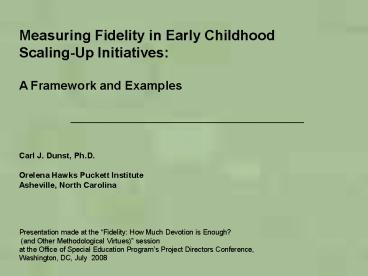Framework for Developing Evidence-Based Early Literacy Learning Practices - PowerPoint PPT Presentation
1 / 25
Title:
Framework for Developing Evidence-Based Early Literacy Learning Practices
Description:
Measuring Fidelity in Early Childhood Scaling-Up Initiatives: A Framework and Examples Carl J. Dunst, Ph.D. Orelena Hawks Puckett Institute Asheville, North Carolina – PowerPoint PPT presentation
Number of Views:202
Avg rating:3.0/5.0
Title: Framework for Developing Evidence-Based Early Literacy Learning Practices
1
Measuring Fidelity in Early Childhood Scaling-Up
Initiatives A Framework and Examples Carl
J. Dunst, Ph.D. Orelena Hawks Puckett
Institute Asheville, North Carolina Presentat
ion made at the Fidelity How Much Devotion is
Enough? (and Other Methodological Virtues)
session at the Office of Special Education
Programs Project Directors Conference, Washington
, DC, July 2008
2
Purposes of the Presentation
- Describe a framework for measuring fidelity as
part - of scaling-up early literacy learning
practices. - Define different types of fidelity at different
levels of - training and practice.
- Illustrate how variations in fidelity can be
related to - variations in practice adoption and outcomes.
3
Center for Early Literacy Learning
- The main aims of CELL are to (1) Synthesize
research - evidence on effective early literacy practices,
(2) develop - evidence-based practices from the research
syntheses, - (3) evaluate the validity and use of the
practices, and (4) - conduct both generalized and specialized
technical - assistance promoting adoption and use of CELL
practices.
4
From Evidence-Based Practices to Fidelity to
Outcomes
Developing Evidence-Based Early Literacy Learning
Practices
Scaling-Up the Use of the Practices
Measuring the Fidelity of Use of the Practices
Child Outcomes
5
Early Literacy Learning
6
Specialized Technical Assistance
7
Framework for Measuring Fidelity
8
Types of Fidelity
Implementation
Diffusion
Intervention
9
Implementation Fidelity
- Implementation fidelity is defined as the degree
to which - CELL training activities of known characteristics
are - implemented as planned and promote participant
- understanding of the known characteristics of the
evidence- - based practices constituting the focus of
training.
10
Diffusion Fidelity
- Diffusion fidelity is defined as the degree to
which second - and third generation technical assistance
providers use - CELL training methods and procedures of known
- characteristics to promote end-user understanding
of the - key characteristics of evidence-based practices.
11
Intervention Fidelity
- Intervention fidelity is defined as the extent to
which end - users adopt and use instructional practices of
known - characteristics for implementing evidence-based
practices - of known characteristics.
12
Elements of Fidelity
- Each type of fidelity includes two elements
- Fidelity of the training processes (how)
- Fidelity of practice understanding and adoption
(what)
13
Elements of Fidelity
- Training processes are HOW we promote adoption
and use - of WHAT we want implemented by end-users. As
state by - Fixsen et al. (2005), it is important to be aware
of the - difference between the practices constituting the
focus of - training and the training methods used to promote
adoption - of the practices.
14
Framework for Structuring Fidelity Assessments
15
CELL Fidelity Checklist for MeasuringImplementati
on and Diffusion Fidelity
- Fidelity of both implementation and diffusion
training is - being measured by a CELL fidelity checklist that
assesses - the degree to which CELL training processes and
CELL - practices are accomplished with (1) sufficient
dose (2) - and with ample quality exposure to (3) key
training and - practice characteristics, and (4) are viewed by
participants - as socially valid.
16
(No Transcript)
17
Measuring Fidelity of Intervention
- Fidelity of intervention is measured in terms of
practitioner - or parent, or both, use of instructional
practices and - evidence-based practices of known characteristics
as part - of the provision of everyday early childhood
intervention. - Fidelity is measured by the frequency and number
of - practices that are used and the
development-enhancing - qualities (active ingredients, core features,
etc.) of the - intervention practices. The social validity of
both the - practices and the child outcomes from using the
practices - are also assessed.
18
(No Transcript)
19
(No Transcript)
20
(No Transcript)
21
Relationship Between Fidelity and Child Outcomes
Low Users
High Users
a
a
d
Practice Measures
Mean
Mean
F-Test
Cohens
Number of Weeks -.21
.16 1.26 .37
Number of Learning Games -.32
.32 5.70 .67
Game Characteristics -.61
.51 5.73 1.32
a
Mean standardized score.
p lt .05.
22
Further Evaluation of the Effectivenessof the
Practice
- Additional information about the effectiveness of
the - practices was determined by a post-test only
quasi- - experimental between group design that included
two - outcomes, one of which was a dependant variable
that a - treatment should affect and a second dependant
- measure that was not expected to be related to
the use of - the practice (Shadish et al., 2002, p.184).
Obtaining an - expected group by outcome measure interaction was
used - to ascertain effectiveness.
23
(No Transcript)
24
Conclusions
- Fidelity is important as part of ascertaining the
adoption and use of evidence-based practices. - A fidelity framework can help structure the
development and collection of fidelity measures. - It is important to measure both implementation
and intervention fidelity. - Relating variation in fidelity to variation in
outcomes can help identify what matters most in
terms of targeted practices.
25
For More Information Visit
- www.puckett.org for methods and procedures for
identifying evidence-based practices - www.earlyliteracylearning.org for information on
the Center for Early Literacy Learning.

